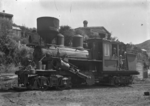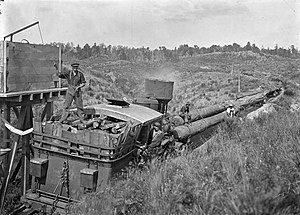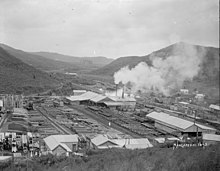Ellis and Burnand Tramway (Mangapehi)
| Ellis and Burnand Tramway | |||||||||||||
|---|---|---|---|---|---|---|---|---|---|---|---|---|---|
|
Climax locomotive with a
log train on the forest railway near Mangapehi around 1922 | |||||||||||||
| Route length: | 18-23 km | ||||||||||||
| Gauge : | 1067 mm ( cape track ) | ||||||||||||
| Maximum slope : | 66 ‰ | ||||||||||||
|
|||||||||||||
The Ellis and Burnand Tramway was operated from 1903/04 to the end of the 1960s Cape Gauge - forest railway 18 to 23 kilometers in length with partly wooden rails near Mangapehi on the North Island of New Zealand .
history
planning
After the New Zealand Railways Department (NZR) North Island Main Trunk Railway (NIMT) was completed on the North Island Volcanic Plateau , John William Ellis and Harry Burnand planned to build a forest railroad from their sawmill at Mangapehi station 30 km south of Te Kuiti into the bush overgrown with Totara and Rimu . During this time, the NZR needed many Totara wooden sleepers for railway construction. In 1900 10,000 sleepers were delivered to Mangapehi and in 1901 even 20,000 to Ongarue . In 1903 5,000 were delivered to Mangapehi and another 3,000 to Ongarue.
construction
Construction began in 1902, allowing the Mangapehi sawmill to open in 1903/04 and the first 18 kilometers of the 1067 mm (3 ft 6 in ) track gauge of the forest railway line . Railway construction continued in 1904. 1905 was Climax locomotive of the B-Class from Pennsylvania imported, the steep routes with 66 ‰ (1: 15) better than the previously used draft horses could handle. The Mangapehi sawmill already had a 14-mile forest railway network in 1909, which had been laid for an average of £ 1,000 a mile.
business
John William Ellis was a confidential advisor to the Māori King Tāwhiao , which helped him to obtain the timber rights in extensive bush areas near Manunui , Otorohanga and the Mangapehi River , so that he focused on the timber trade and in 1897 closed his previously operated shops. As a result, his company expanded unusually quickly, about which he said in 1909: “My company has no royal land for the sawmill operation other than the land on which the sawmills are in Manunui and Mangapeehi. Our timber rights are based exclusively on contracts with the natives " (My company hold no Crown land for sawmilling purposes other than the sawmillsites at Manunui and Mangapeehi. Our timber-rights are all in the form of agreements with Natives) . Other sawmills established in the 1900s struggled to obtain usage rights for the native bush. Expansion was also accelerated by the development and use of steam-powered winches instead of ox-drawn carts, which enabled otherwise inaccessible bush areas to be profitably cut down.
Performance
The net present value of Ellis and Burnand's in 1903 was about £ 30,000. In order to finance the complex development, the company negotiated with the Kauri Timber Company in Melbourne , which in 1904 took a 47.5% stake in Ellis and Burnand. The Mangapehi sawmill made no profit until 1907, but from 1908 to 1911 it made about £ 10,000 to £ 18,000 a year at a time. The company's value had risen to £ 75,000 by 1909. The company employed 300 to 400 people in four King Country locations and felled and processed 460,000 cubic meters (1.5 million feet) of wood per year.
building
The sawmill in Mangapehi was so remote that the company was developing a meeting hall, a social club, billiards room, bowling, croquet, tennis, soccer fields, a cricket field, a post office, a school and a shop , had to build a doctor's office, an ambulance hall, a public library and a train station.
Profitability and closure
The company benefited from inflation from 1908 to 1924, which increased revenue from lumber due to a contract signed in 1925. During this time, nearly 200 people worked in Mangapehi. After the Hayward Timber Company acquired the three other sawmills and woodlands of Ellis and Burnand in Waimiha in 1936 , the latter were largely deforested by 1945, so that the huts, the saw and most of the employees were relocated to Mangapehi. The sawmill there continued to operate and was closed in the late 1960s.
remains
There is still a wooden station building in Mangapehi. In addition, five steam locomotives used in Mangapehi have been preserved in various locations in New Zealand:
| Wheel alignment | Manufacturer | Factory number, year of manufacture | commitment | Current location (2008) |
|---|---|---|---|---|
| 0-4-4-0BT | Climax Manufacturing Co. | No. 1650 from 1924 | 1960-1969 J. Melse, Mangapehi | Bush Tramway Club, Swabey & Willmot |
| 0-4-4-0BT | Climax Manufacturing Co. | No. 522 from 1904 |
 1904-1954 Ellis and Burnand, Mangapehi |
Tokomaru Steam Museum |
| 0-4-4-0BT | Climax Manufacturing Co. | No. 1203 from 1913 | 1944-1953 Ellis and Burnand, Mangapehi | West Coast Historical & Mechanical Society, Shantytown |
| 0-4-4-0T | A. & G. Price | No. 111 from 1923 | 1935-1944 Ellis and Burnand, Mangapehi | Bush Tramway Club, Swabey & Willmot |
| 0-6-0ST | Dübs & Co | No. 1364 of 1880 | 1946-1956 Ellis and Burnand, Mangapehi | Hamilton Park |
See also
Individual evidence
- ^ Trade and Labor Notes. . In: Auckland Star , September 30, 1903, p. 2. Retrieved March 23, 2018.
- ↑ Appendix to the Journals of the House of Representatives 1901 Session I Public Works Statement byy the Hon. W. Hall-Jones, Minister for Public Works, October 22nd, 1901 . Retrieved March 22, 2018.
- ^ A b c Philip Cleaver: Maori and the Forestry, Mining, Fishing, and Tourism Industries of the Rohe Potae Inquiry District 1880–2000 . February 2011.
- ^ News from Country. Districts. . In: New Zealand Herald , March 3, 1902, p. 7. Retrieved February 16, 2018.
- ↑ Jeff Downs : Valder, Henry . In: Dictionary of New Zealand Biography . Ministry for Culture & Heritage , 1996, accessed September 10, 2018 .
- ↑ a b c 1953 Jubilee Year: Half a Century of Progress in the Timber Industry of New Zealand, 1903–1953. | National Library of New Zealand .
- ^ The Main Trunk Line. . In: New Zealand Herald , May 6, 1903, p. 3. Retrieved March 23, 2018.
- ↑ Local and General. . In: Waikato Times , March 23, 1904, p. 2. Retrieved February 16, 2018.
- ^ Waikato Argus . April 18, 1905, p. 2. Retrieved February 17, 2018.
- ^ The Waikato Argus . January 14, 1905, p. 2. Retrieved February 17, 2018.
- ↑ a b c Report of Commission on the Timber and Timber-Building Industries; together with Minutes of Proceedings and of Evidence. . 1909.
- ↑ Obituary . In: Waikato Times , Aug 6, 1918, p. 4. Retrieved February 10, 2018.
- ^ Progress in the King Country . In: Waikato Times , June 14, 1906, p. 3. Retrieved February 16, 2018.
- ^ New Zealand Parliament: Parliamentary Debates 1924.
- ^ Maoris and Timers. . In: New Zealand Herald , April 30, 1925, p. 10. Retrieved March 23, 2018.
- ^ The King Country. . In: New Zealand Herald , November 19, 1925, p. 13. Retrieved March 23, 2018.
- ↑ Kerryn Pollock : Mangapēhi , 1955. In: Te Ara - the Encyclopedia of New Zealand . Ministry for Culture & Heritage , March 30, 2015, accessed September 10, 2018 .
- ↑ Mangapehi Rail Station on Flickr. Retrieved July 24, 2018.
- ↑ David Maciulaitis: New Zealand Rolling Stock Register. Retrieved July 24, 2018.
Coordinates: 38 ° 30 ′ 34 ″ S , 175 ° 17 ′ 58 ″ E





